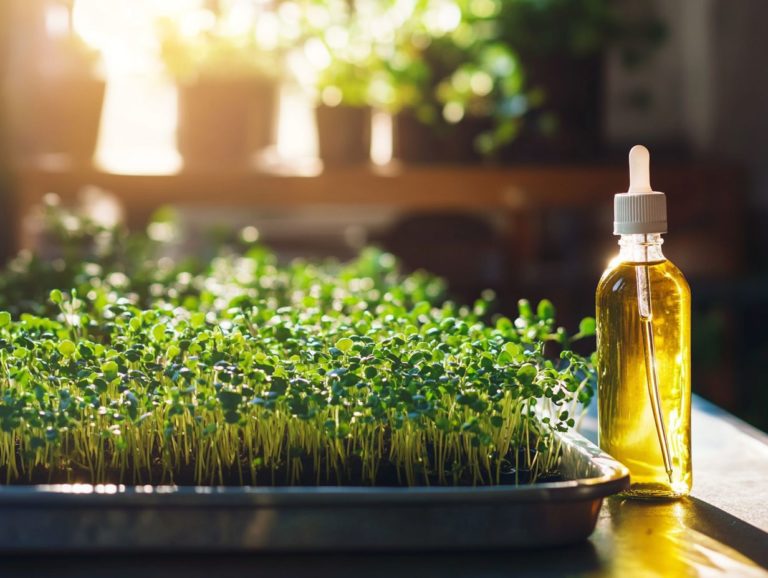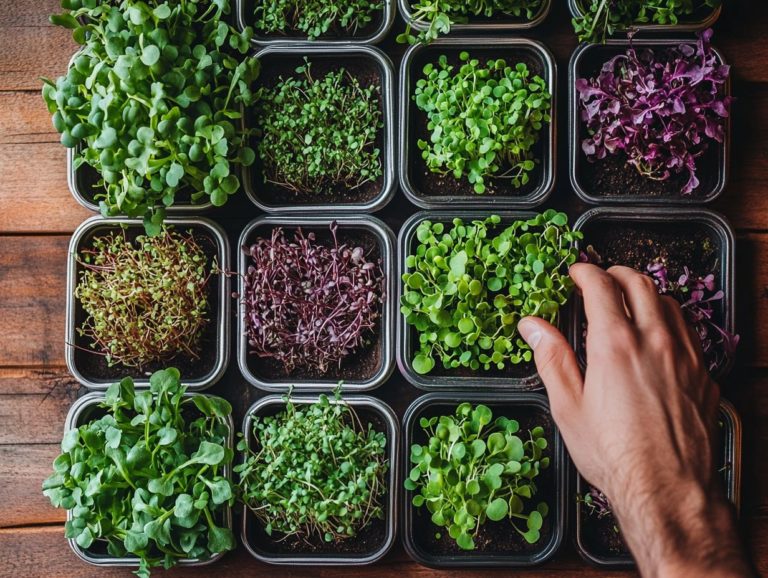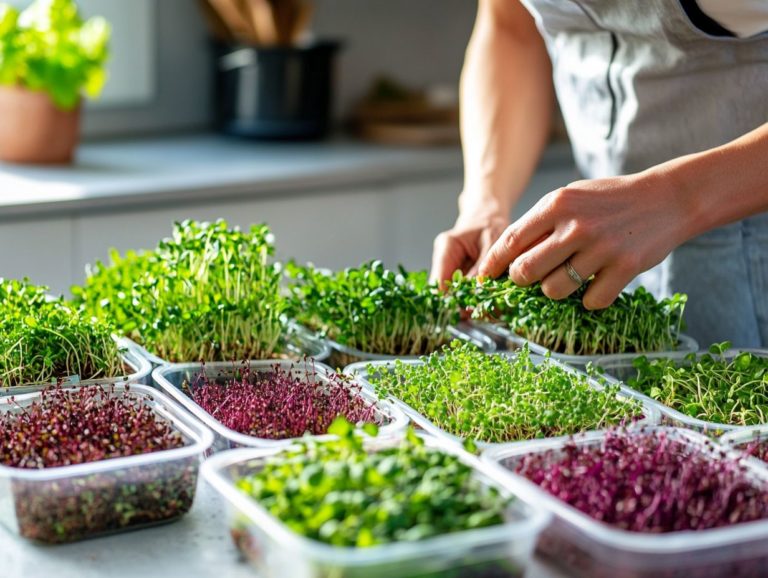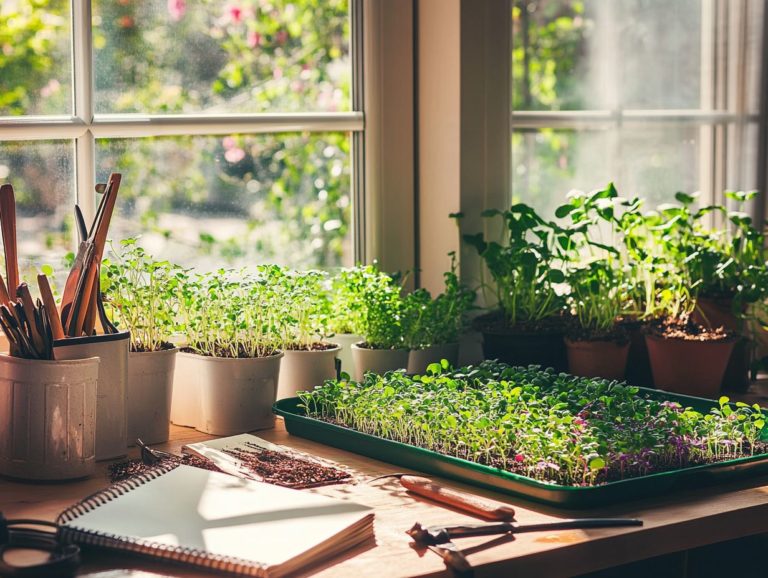What Is the Cost of Growing Microgreens?
Microgreens have become a favorite in the cooking scene. They offer vibrant flavors and impressive nutritional benefits.
Have you ever wondered about the true cost of these tiny greens? This article covers everything from the basics to the factors affecting your growing expenses.
We ll explore seed prices, essential tools, and labor costs. With practical tips, you can cultivate microgreens without breaking the bank.
Whether you re a newbie or a seasoned grower, you ll uncover exciting tips that make growing microgreens fun!
Contents
Key Takeaways:
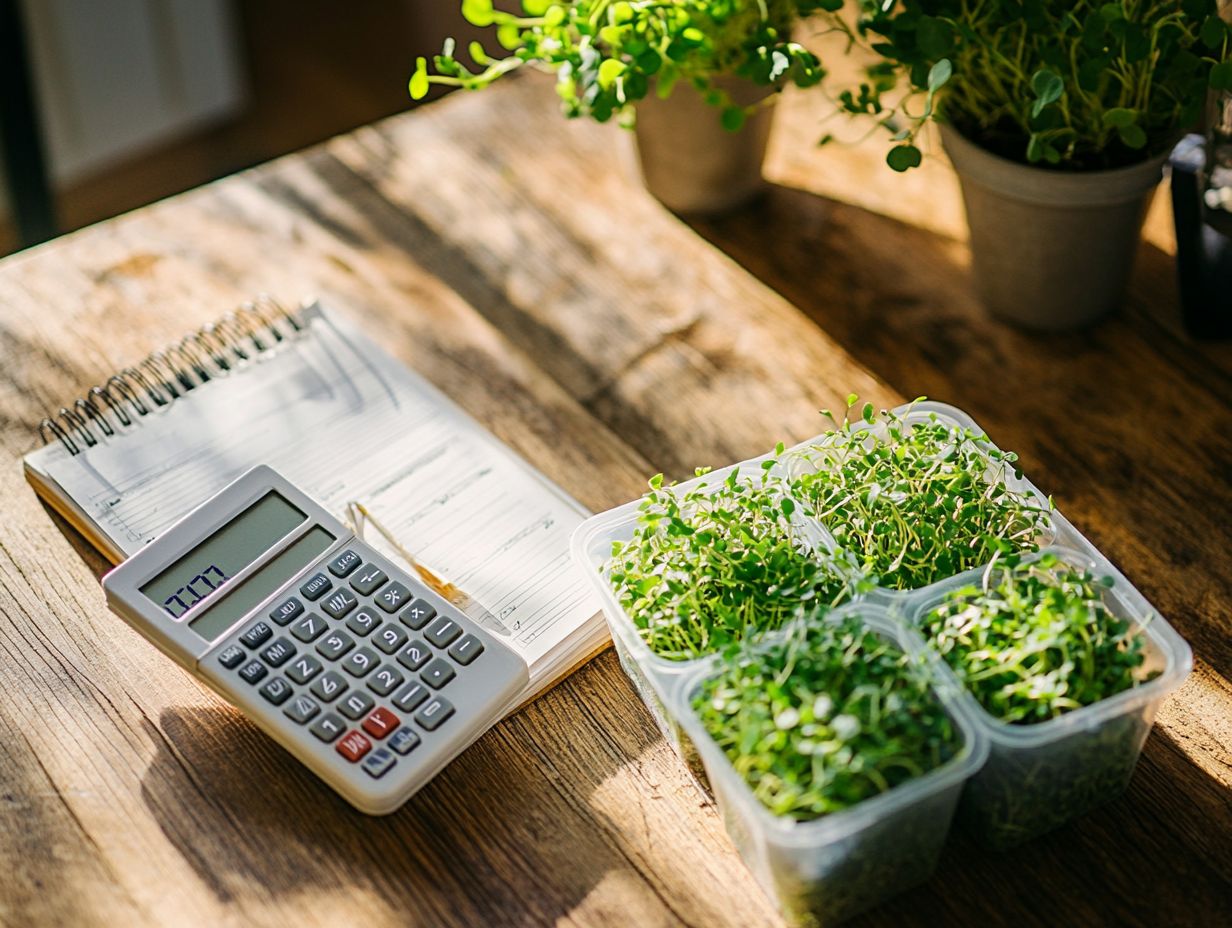
Definition and Popular Varieties
Microgreens are young, edible plants harvested shortly after their first true leaves appear. Varieties like arugula, basil, and radish add color and flavor to your dishes while providing great nutrition.
With healthy eating on the rise, demand for microgreens has surged. They are now a popular choice in grocery stores, farmers’ markets, and restaurants.
These tiny powerhouses are packed with vitamins, minerals, and antioxidants. They often offer far more nutrients than their mature versions.
Grown from organic seeds, like those from jPure Farms, microgreens are easy to grow and quick to harvest. They re perfect for both home gardeners and commercial growers.
You can easily add them to salads, sandwiches, and smoothies. This choice not only enhances your meals but also supports sustainable eating practices.
Why Grow Microgreens? Understanding the Business Potential
Growing microgreens is not just a sustainable business; it s rewarding too. This aligns with the growing consumer demand for nutrient-rich, health-focused food options.
With their minimal space requirements and quick growth rates, microgreens thrive in various settings. They’re an excellent choice for local markets and health-conscious buyers.
Benefits and Uses
Microgreens provide benefits that extend beyond culinary uses. They are rich in essential nutrients and bold flavors, elevating any dish.
These tiny greens, from arugula to beet tops, introduce vibrant colors and textures. Research shows they can have up to 40 times the nutrients of their mature forms.
Adding microgreens to your meals boosts both flavor and visual appeal. Sprinkle them on soups or blend them into pesto; their versatility invites creativity in your cooking.
Factors Affecting the Cost of Growing Microgreens
The cost to grow microgreens depends on key factors like operational expenses, seed prices, and growing conditions. Understanding these elements is crucial for profitability in this niche market.
For aspiring growers, mastering these details can help establish a successful microgreens business.
Seed Costs
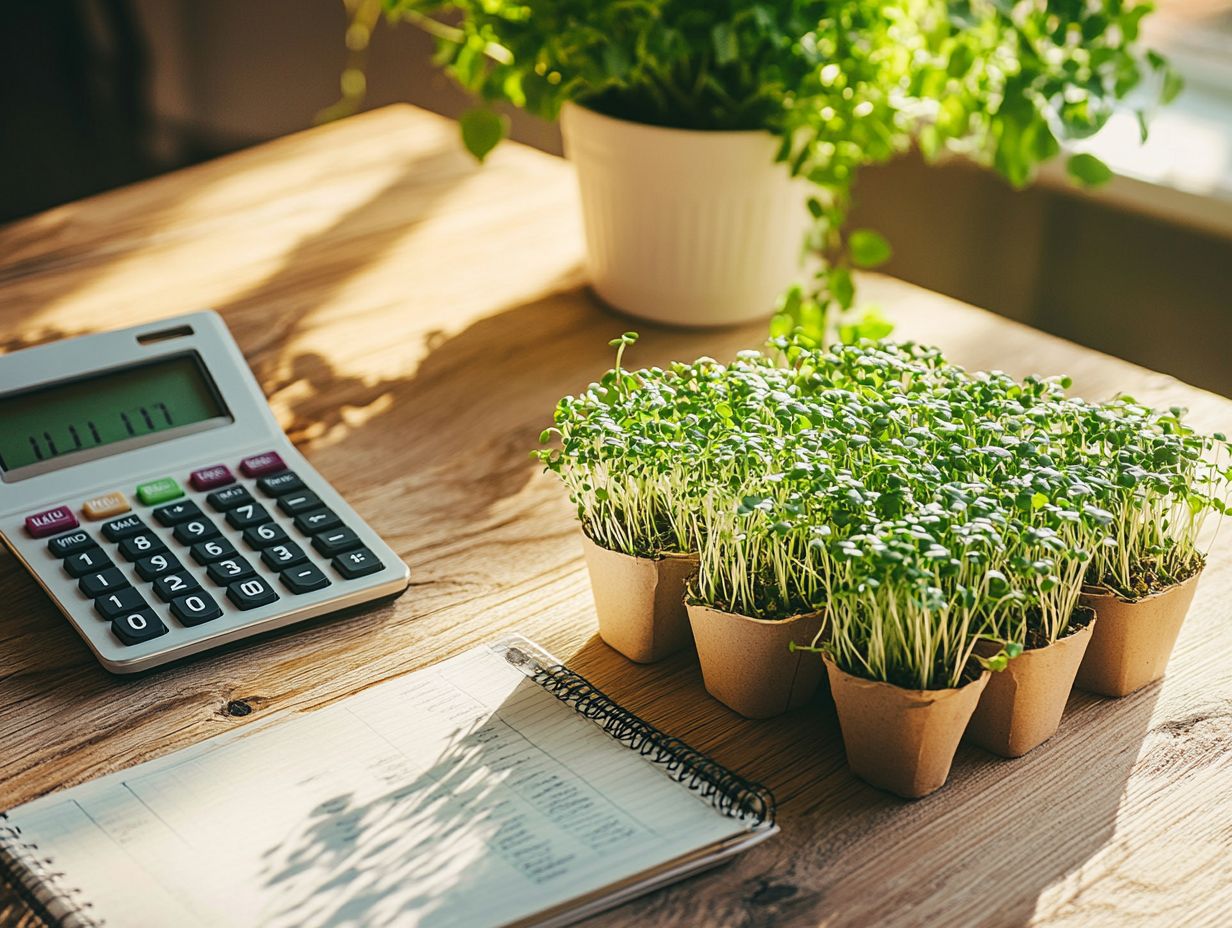
Seed costs are crucial to the overall expenses when embarking on your microgreens venture. While opting for organic seeds may inflate your supply costs initially, they often lead to a superior product. Grasping the price differences between conventional and organic seeds is essential for your financial planning and profitability.
Your seed choices will affect your initial expenditures and shape your long-term marketability and consumer appeal. Although organic seeds may come with a higher upfront price, they frequently yield crops that can command premium prices in the marketplace, thanks to the increasing demand for organic produce.
As you evaluate your seed starting costs, it’s crucial to act on these factors now for better growth. Investing in organic seeds can elevate growth quality, offer enhanced nutritional benefits, and attract customers who value sustainability. Ultimately, choosing organic seeds can boost your profits and lead to a healthier bottom line for your business.
Growing Supplies and Equipment
The right growing supplies and equipment, like grow lights and trays, are absolutely crucial for your success in indoor gardening and vertical farming of microgreens. They ensure optimal growing conditions and can significantly enhance your yield estimates. Investing in quality gardening supplies will profoundly impact the efficiency and profitability of your microgreens venture.
To achieve the best results, consider incorporating seedling mats into your setup. These mats provide consistent warmth, which is vital for the process of seeds sprouting into plants. A reliable humidity dome helps maintain moisture levels, essential for nurturing those tender seedlings.
Utilizing organic soil or a suitable growing medium boosts nutrient availability and enables the microorganisms that are key to healthy plant growth. Don t overlook adequate drainage trays; they prevent waterlogging and ensure your roots stay healthy and thriving.
By assembling these essential items, you can create a flourishing microgreens setup that maximizes space, minimizes waste, and facilitates a bountiful harvest all while embracing the principles of sustainability in urban agriculture.
Time and Labor
Time and labor are pivotal elements in the success of your microgreens venture, directly influencing labor costs and efficient crop management practices.
Investing your time wisely allows you to refine your processes, ensuring that every phase from planting to harvesting is executed with precision. Effectively managing labor can help you reduce the risks associated with delayed harvests and spoilage, which ultimately affects your profitability. By implementing strategies like accurate scheduling and skilled labor allocation, you can achieve optimal results while keeping operational costs in check.
Taking a thoughtful approach to time and labor not only enhances efficiency but also elevates the quality of the microgreens you produce, contributing to a sustainable and profitable growing enterprise.
Other Expenses
Along with seed, supplies, and labor, you ll find that overhead expenses and other costs, such as packaging choices and delivery systems, can greatly influence the financial outcomes of your microgreens venture. Keeping a close eye on these additional expenses is essential for maintaining a healthy profit margin and crafting competitive pricing strategies.
For example, choosing eco-friendly packaging options may attract environmentally conscious consumers, but it often comes with a higher price tag, which can reduce your profits if not managed carefully. The logistics of delivery think transportation and storage also play a crucial role in your overall expense structure.
By weighing the trade-offs between quality packaging and delivery options, you can strike a balance that maximizes customer satisfaction while protecting your bottom line. Grasping these nuances enables you to make informed decisions that directly impact your profitability and long-term success in the microgreens market.
Calculating the Total Cost
Calculating the total cost of growing microgreens requires a meticulous approach to financial planning. You must consider every variable, from seed costs to running costs.
This comprehensive analysis supports you in making precise profit projections and allows you to evaluate your production strategy, ensuring long-term sustainability in your venture.
Sample Cost Breakdown
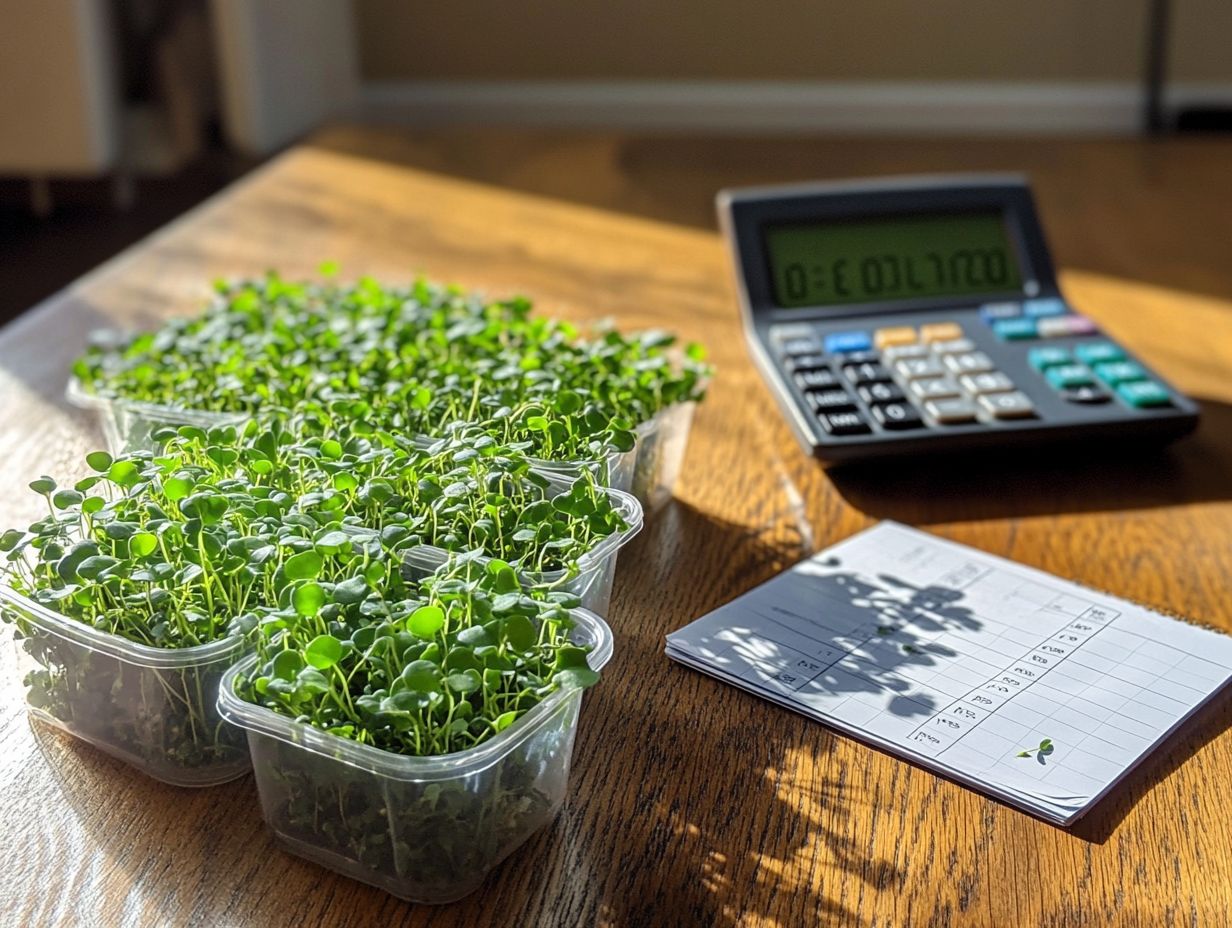
A detailed cost breakdown for growing microgreens offers you invaluable insights into the startup expenses involved. This breakdown includes key categories such as seeds, supplies, labor, and overhead expenses.
By carefully analyzing each category, you can develop a clearer understanding of your investment requirements. For instance, seeds are a vital component, necessitating initial capital investment alongside ongoing costs as the growing cycle unfolds. Supplies think soil, trays, and lighting significantly add to your overall expenses.
Labor costs are crucial in shaping your pricing framework. Don t forget about overhead expenses like utilities and rent, which can complicate your financial picture. Grasping these elements aids in budgeting and enables you to strategically position your pricing, ensuring profitability in a competitive market.
Tips for Reducing the Cost of Growing Microgreens
You can boost your profits by using smart cost-saving strategies! Implementing these strategies is crucial for minimizing the expenses tied to growing microgreens, allowing you to elevate operational efficiency and maximize profit margins.
By analyzing your expenditures and optimizing your resources, you can significantly reduce overall costs without compromising on quality.
Cost-Saving Strategies
Cost-saving strategies like budgeting and optimizing resources can significantly reduce your expenses in microgreens cultivation. This enables you to achieve better profit margins and sustainability.
- Implement techniques such as bulk purchasing and local sourcing of seeds to lower initial costs.
- Embrace efficient growing methods like hydroponics a method of growing plants without soil or vertical farming to maximize space and yield while minimizing waste.
- Track your expenses diligently to identify areas where savings can be made, such as cutting utility costs with energy-efficient lighting or recycling packaging materials.
Together, these approaches not only bolster your financial health but also promote a more sustainable way of producing microgreens.
Frequently Asked Questions
Got questions? Here s everything you need to know about growing microgreens!
What Is the Cost of Growing Microgreens?
The cost of growing microgreens can vary depending on several factors, such as the type of microgreens, the amount of space available, and the supplies needed. However, on average, it can cost anywhere from $20 to $100 to start growing microgreens.
What supplies do I need to start growing microgreens?
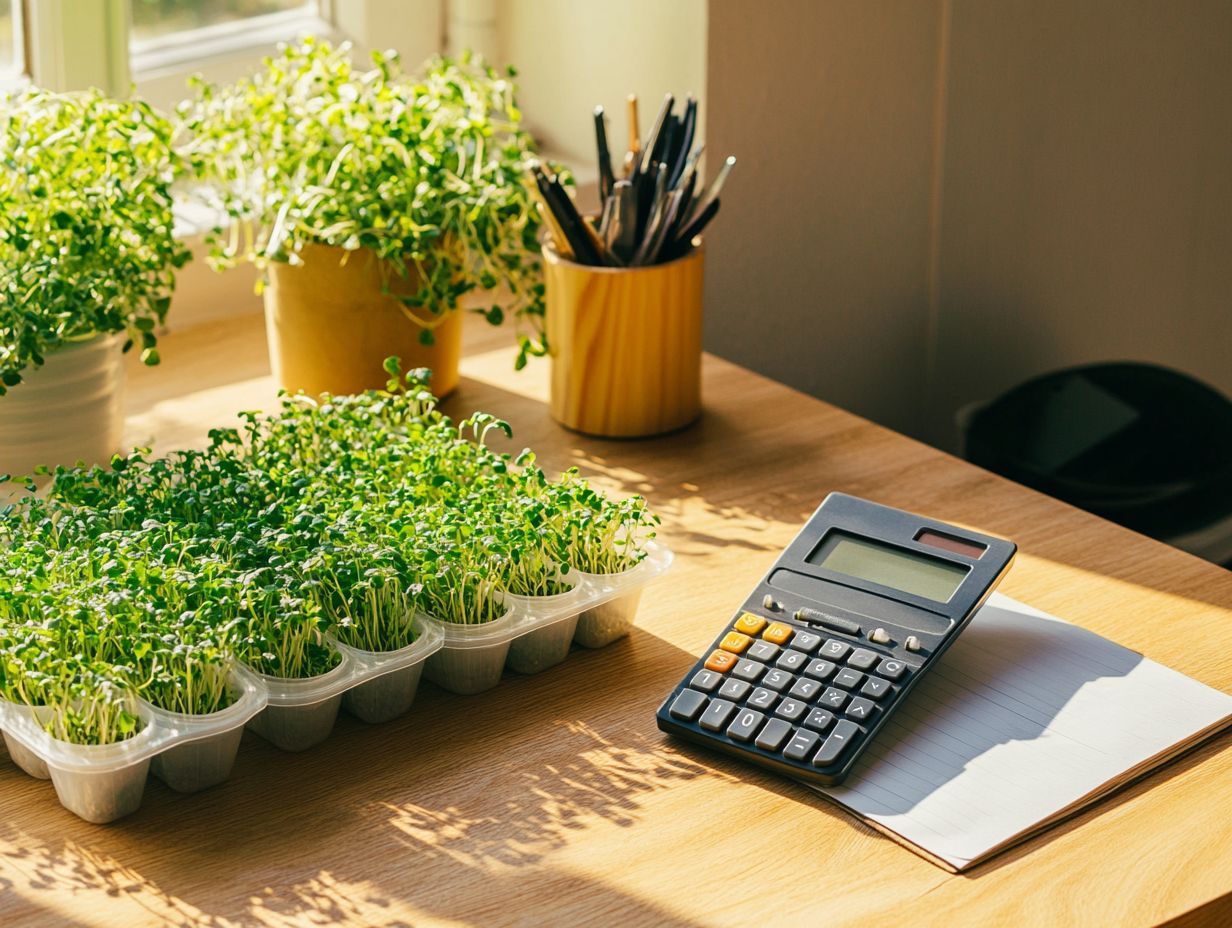
To start growing microgreens, you will need:
- A container or tray
- Potting mix
- Seeds
- Water
- Light
Additional supplies such as a spray bottle, fan, and grow lights may also be helpful.
Do I need a lot of space to grow microgreens?
No, microgreens can be grown in small spaces like a windowsill or countertop. You can also use vertical garden systems to maximize space and grow more microgreens in a small area.
How much time does it take to grow microgreens?
The time it takes to grow microgreens can vary depending on the type and environmental conditions. On average, it takes 1 to 2 weeks for microgreens to reach maturity.
Can I save money by growing my own microgreens?
Yes, growing your own microgreens can save you money in the long run. Buying microgreens from the grocery store can be expensive, but growing them at home can be more cost-effective.
Are there any ongoing costs associated with growing microgreens?
Yes, you will have some ongoing costs, like buying seeds and supplies. However, these costs are much lower than continuously purchasing microgreens from the store.
You can also save money by harvesting seeds from your microgreens for future use. Growing microgreens is a fun and rewarding way to boost your savings!



